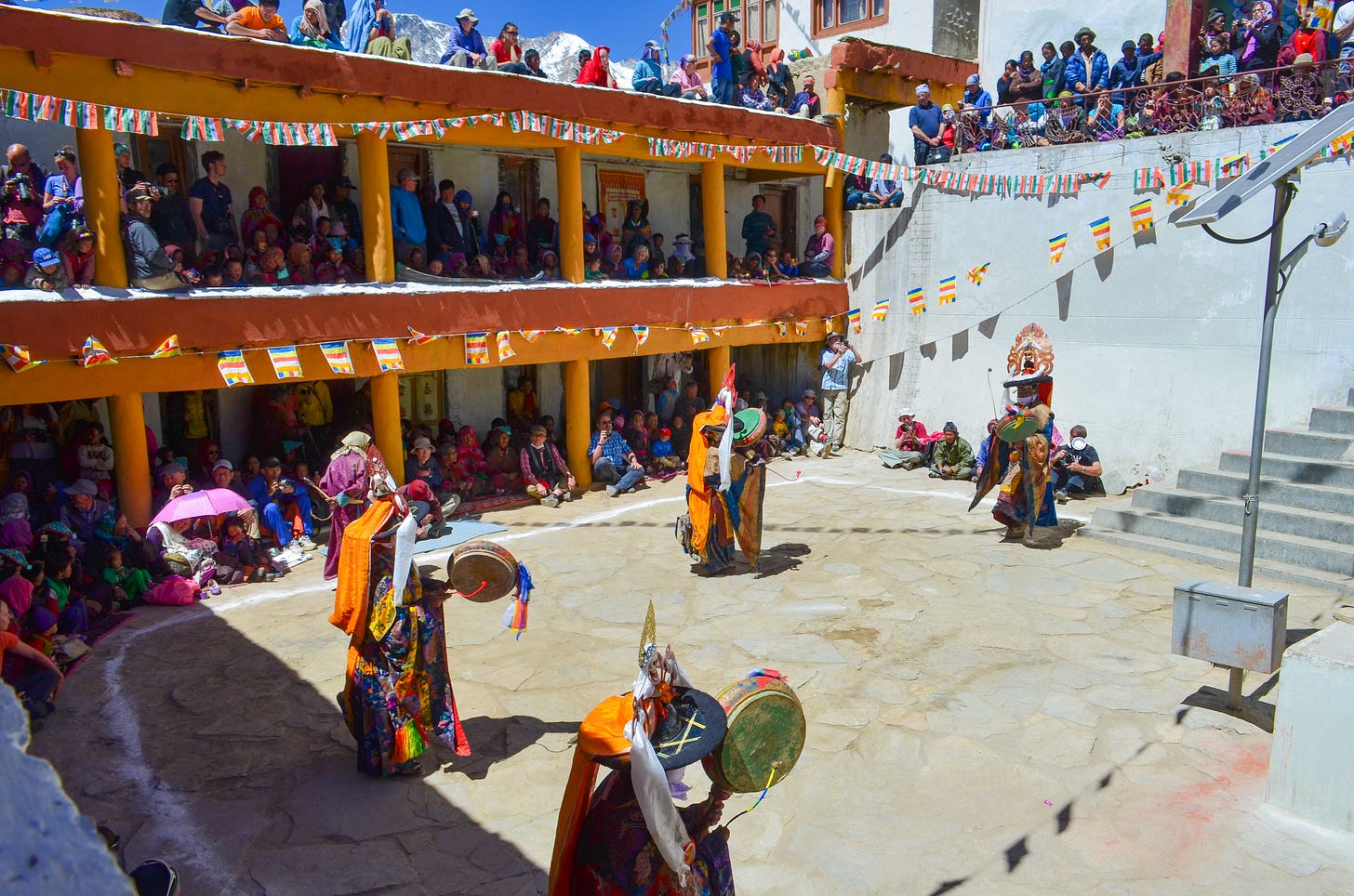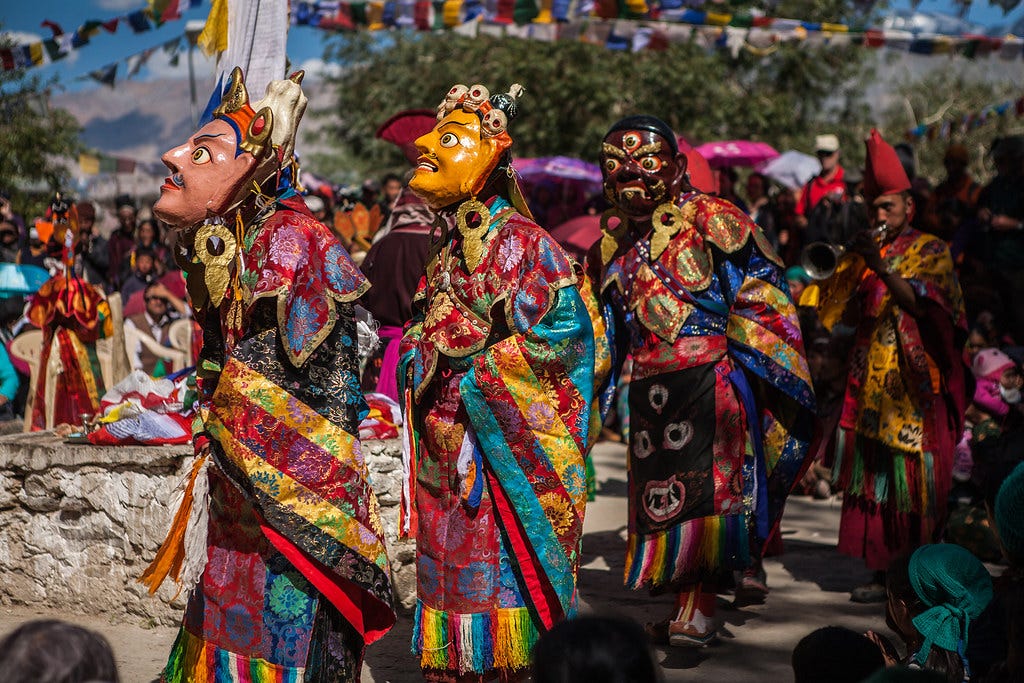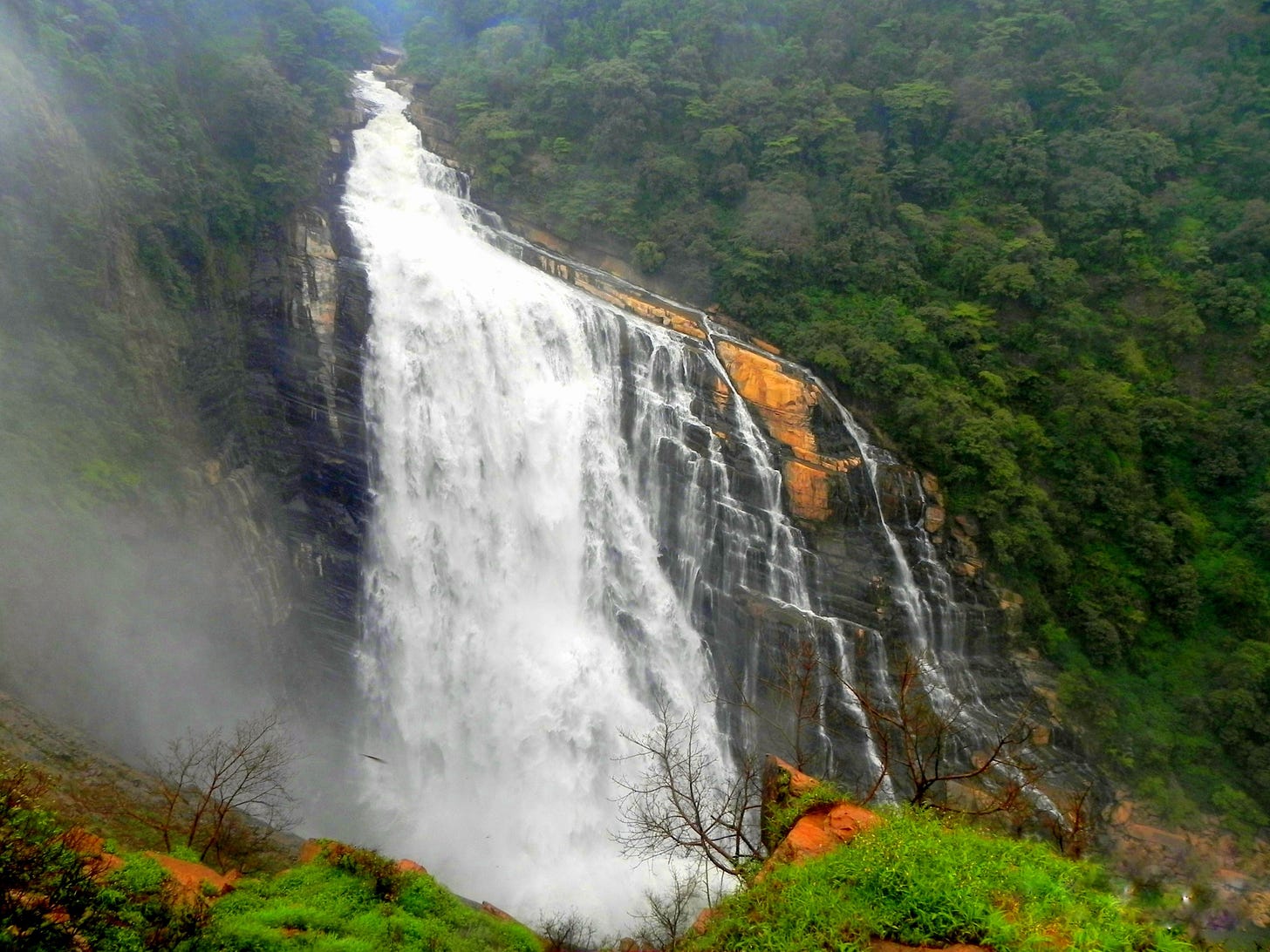#12: Role of the Divine in the Human-Environment relationship: Daiva-Devata traditions from across India
The Kāntara movie has powerfully showcased the role of Daiva or protector deities in forest-dwelling societies of costal Karnataka, this post explores other such traditions from across the country.
It was the summer of 2013. On a hot afternoon in Korzok, the village on the banks of Tso Moriri, a lake on the Indo-Tibet border at nearly 15,000ft, I waded among hoards of Changpa nomads to climb the stairs of the Korzok Monastery. As I was climbing upto the top floor of this 300-year old building (I wanted to have the best view of the proceedings), a thundering whiplash struck my shoes. I looked up frightened, only to see a man wearing one of those scary face masks of Tibetan Buddhist deities/demons, staring at me. Another whiplash struck, this time hitting the ground, accompanied by a loud growl, instructing me to head back down. I nervously back-tracked, still making eye contact with the massive mask, not knowing how to respond. It was my first time attending such a festival at a monastery, so I obviously did not know about the sanctity/ sensitivity of the rituals, and no-go zones. Safe to say, I got a rude reminder.

While I enjoyed the rest of the festival, watching the various Cham dances dedicated to different deities and demons, the above incident shook me. It pushed me to know more about these Ladakhi festivals, their history and the belief system on which these rituals are practised. The inquiry opened me upto the world of the Oracles - where a deity descends on an individual for a brief period, and through them, interacts with the larger society. The deities listen to people’s problems, offer advice and remedies, fixes feuds, recommends the path to follow for both individuals and the society at large. It was a revelation!
It took me many years and travelling across different states of India to realise that this phenomenon was not limited to Ladakh, but was a pan-Indian tradition. The recently released Kannada movie Kāntara, which spectacularly portrays one such tradition from coastal-Karnataka called Daiva-Āradhana, inspired me to write this post. Let us look at a few other similar traditions from other parts of India - traditions that weave together the individual, the divine, the society and their own local environment. While such traditions are there in every nook and corner of the country, for the sake of this post, I will try to limit it to traditions from the parts of western-ghats and the Himalaya, as they are the ones I am most familiar with - The Daiva-Āradhana from Karnataka, The Devta Patt from Himachal and Nag-rang festivals in Ladakh.
The sacred Daiva-Devata worship
So what is the ritual about? Like all things traditionally and quintessentially Indian, there is no standard. There are hundreds of Devta-s (over 300) in Himachal Pradesh, hundreds of Daiva-s/Bhuta-s from Western Ghats and the surrounding regions of coastal Karnataka and Kerala, and tens of Rongtans/Lhas spread across Ladakh, Spiti and Tibet. Each of these deities, have their own sacred space, and rituals are specific to each deity. But again, just because Indian traditions are diverse, does not mean that they are devoid of intrinsic unity. There are common threads running across these customs practiced thousands of kilometers away, lets us analyse a few of them.
Descent of the divine - Daiva Paatri / Gur / Rongstan
The most important person in this ritual is the person that gets possessed by the deity. In coastal-karnataka, the person is called Daiva Pātri, in Himachal they call them Gur-s or Kardhar-s, and in Ladakh they are called Rongstan-s. Across regions, these individuals who channel the divine through their bodies are supposed to lead what is considered a shuddha or a pure lifestyle. This means they are forbidden from certain actions and also from consuming Tāmasa āhara, like eggs and meat for a certain period - usually a month or two - before the ritual is due to take place. Some adhere to these norms throughout their lives and not just pre-ritual. In Karnataka, they say that the person should have Daiva kaLe (ದೈವ ಕಳೆ) - a glow/persona on his face befitting the deity’s residence. While the terminologies might be different in different regions, this is the bottom line, the body should be worthy of invoking the deity during the ritual. For it will be the abode of the sacred.

Aesthetics that elevate - Sounds and visuals
Considering that the human body is hosting the divine, it needs to be decorated and embellished in a manner which represents the Daiva/Devta. The look is carefully chosen based on the Daiva being invoked and again in all three regions, the customs go into intricate detail as to how the person should look. In Dakshina Kannada, the face is painted completely along with a few markings around the eyes and the forehead, complemented by jewellery, flowers and decorations done from various locally found flora. In Ladakh, the Rongstan-s wear specific masks over their faces and silk robes on their torso with large eyes drawn on them. Additionally, embroidery of various traditional Buddhist motif-s are done on the clothes. In Himachal though, the decoration happens only to the Devta who is carried on the head and not the person.
The visual spectacle is complemented by the movements, with each deity walking in a certain royal gait, in sync with the rhythmic drums which gradually increase in both intensity and speed. The whole setting creates an atmosphere of euphoria, an elevating experience for all present in the temple/monastery premises. Interestingly, the instruments are very similar in these ceremonies across the country. There is one low volume drone instrument which provides the base frequency while the Shehnai/Nādaswara type reed-pipe instruments play the tunes, creating a hypnotic atmosphere. Along with them, striking metal symbols of various sizes and gurgling anklets add to the aura. Even in certain Devta rituals in Uttarakhand called the ‘Jāgar’, the same set of instruments are played. The visual and acoustic aesthetics is at the core of these rituals, where tradition dictates every minute detail which are adhered to the tee.
Interaction, not just commandments
Probably the most fascinating aspect of these festive rituals is that the divine - a metaphysical entity - is invoked in a person, thereby being accessible to the people. The Daiva/Devta/Lha reside among the people, they know everyone and what is happening in their lives, they are not alien to the society, nor is the society alien to them.
During the act, it is the Daiva who speaks to the people, hears their troubles, shows the direction in which one should act. This is true for both individuals as well as society at large. A village head/ leader of an area can ask the Daiva-s about issues affecting the entire society, and what is the suitable action that need to be taken and sure enough, the entire society adheres to the words of the Daiva. There is unflinching belief in the tradition for everyone in the community, rarely do people not obey the suggestions. Personal differences are set aside and community acts in unison. I have personally seen the bhaya, bhakti, shraddha - the devotion with which people accept the word of the Daiva, both while I was living in Ladakh and Udupi. One needs to experience it to believe it.
This is because the ritual is not a dance performance or an artistic expression. It is not a belief but a lived, experienced reality for people. The strength and conviction to follow even the most inconvenient of pronouncements of the Daiva/Devta comes from the undoubtable knowledge that it is the Daiva itself that is speaking and not the person who invokes the Daiva.

The sacred geography - Protectors of the environment
The relationship between the people and the Daiva-s is not transactional, i.e., where the well-being of the local populace is not just confined to better financial gain/prosperity. The Daiva-s are protectors of the geography, of the environment - the forests, rivers, meadows and mountain slopes. So, if the Daiva does not agree to a request/proposition of something that on the surface seems like a good development for the society, nobody questions the judgement.
The greatest and the most fascinating example of this was in the Kullu Valley in 2006, where the locals asked the Jagati Devta in a ceremony specially conducted for the purpose, if they should go ahead with a proposed 100 million dollar+ investment into developing a Ski Resort by members of the Ford Corporation. The Devta said no, and the Himachal Pradesh government was pressured into scrapping the lucrative deal. It was reported in the media thus,
“On February 16, 2006, 'gods' came together at the Jagati Patt temple in Naggar village, district Kullu, Himachal Pradesh. Local gods were there to discuss a proposed ski resort in the area. Based on these divine proceedings, the traditional king of Kullu, Maheshwar Singh gave a final verdict -- not an inch of land should be given for the resort. The refusal to give land was because it was supposed to belong to the gods…
.. What followed next might be difficult for a non-believer to comprehend. The representatives were seated in rows and the king went around asking each to speak his or her mind. This prompted the representatives to go into a trance, after which the gods spoke through them. God after god spoke and made it clear that they did not want the ski village in the area since it would desecrate holy places. They warned the people that if the project was approved, the gods would leave and destroy the area. The local people hung on to each word.
Nearly 12,900 hectares of land was to be ‘developed’, much of it was pristine mountain landscape. The HP government had already signed an MoU with the company and hence persisted for over a decade - till as late as 2018 - to continue with the project, but eventually, the Devta-s prevailed. This is the power of their words.
The Devara Kādu-s of Kodagu
The story is not very different in the Western Ghats. If today Kodagu/Coorg, the most commercialised tourist district in Karnataka still has forests left, it is due to the concept of ‘Devara Kādu’ (God’s Forests). As the New Indian Express reports, “Currently, there are nearly 1,214 Devara Kadu in Kodagu covering an area of 4,614 hectares and, 18 native communities are involved in worshiping 165 folk deities”. Even as these ‘Devara kādu-s’ have been nibbled away by commercial interests, whatever is remaining is protected by these local deities and the community, solely because for those people, their Gods who dwell alongside them in their forests are more important, they are the kshetra-pālas, guardians of the land.
This concept of Devara Kādu extends to other regions of the Malenadu region as well. The forests around the Aghanashini river basin, the only free-flowing river left in Karnataka, are also protected fiercely by locals because they believe the forests belong to the Gods. There are annual fairs where people from surrounding villages gather and partake food together as a community camping by the river, the custom called ‘hoLe uuta’ (ಹೊಳೆ ಊಟ).

The Takeaway
The Daiva/Devtas across Bhārata, through their interactions with the people are protecting the natural assets of our land and along with it, people’s interests. Such beliefs and traditions which are passed on orally have preserved the sanctity of our land. They do what no forest ranger or environmental activist can - instil a sense of sacredness to our surroundings. And the sacredness is not imposed, but is an experienced reality of people, which make them stand steadfast against anything that would strip their land of that sacredness. It is of utmost importance that this intimate relationship between the divine, the human and our sacred land is protected and celebrated.
Today, migration of people remains a big challenge in maintaining these traditions - especially when people who do not acknowledge the Daiva-s migrate to these regions, while those who do and worship them are forced to move out for more financially lucrative work. We have lost a lot already, but we still have something to hold onto. Is it not our duty to protect the traditions which protect us?
Let the Daiva-s and Devata-s continue to bless and guide the people of this land!
Sharing two videos that give a glimpse of such Daiva worship events - One from Ladakh of the Matho Nagrang Festival, beautifully filed by Saravana/India in motion. Another from Karnataka, which is just a visual montage of the Kola proceedings. Of course, you can also watch the Kaantara movie running in theatres now to get a much more intense portrayal of the Daivāradhana/ Bhuta-Kola.
It has been a year since I started writing here on Substack. My student days are behind me so I might not find enough time to write regularly. I will certainly keep writing as and when I can, for I still have a lot of stories to tell. Thank you for being a subscriber and giving your time to read. Please do share your feedback on what you think about everything I have posted in the last year, and where you would want me to improve. I would really appreciate it.
Thank you once again and Happy Deepawali :)




As ever, Divine. You are blessed with beautiful assembly of words, keeping it between Mrs. Sudha Murthy and Mr. Taroor. Leaning towards Sudha amma more.
Written beautifully. Good comparison/contrasting of sub-cultural practices. Keep writing!